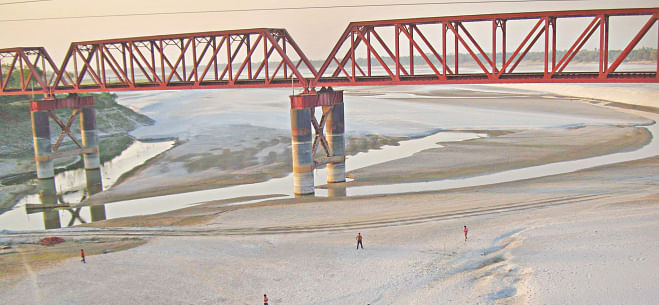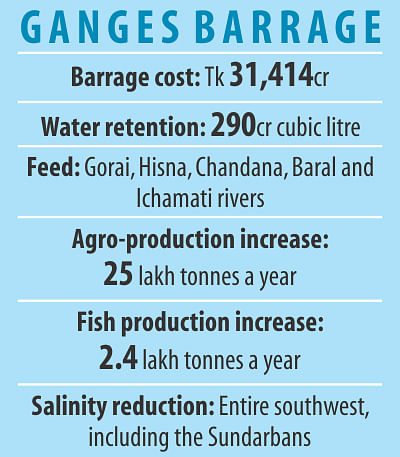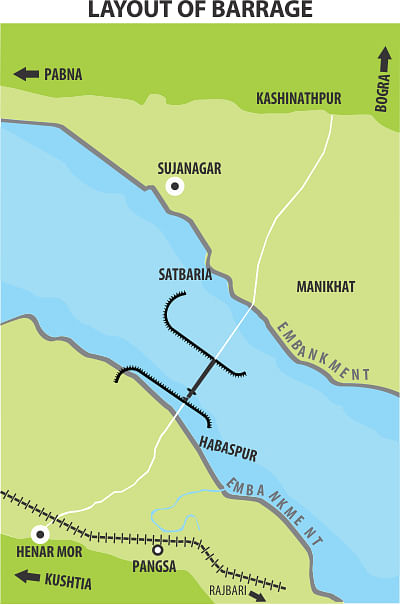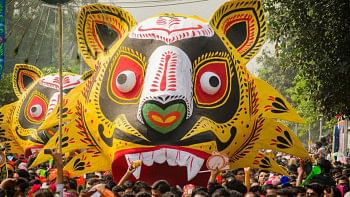Tender by this year

The draft design for the 2.1km-long important Ganges barrage has been finalised and the government plans to float a tender for construction at the end of the year, assuming that the necessary funds are arranged.
In February, the government sought soft loans from China for 14 of its large projects, including the Ganges barrage, and China asked for a feasibility study for the barrage to see its potentials.
The study is already done but the government is yet to send the report to China.

The barrage will retain the water of the trans-boundary Ganges, known as the Padma in Bangladesh, during the monsoon and feed small rivers during the lean season, which will reduce salinity, a major threat to public health and agriculture in the southwest.
The government had taken up a project in 2009 to conduct a feasibility study for the barrage and make a design for it.
The feasibility study estimates that the construction of the Ganges barrage will cost a staggering Tk 31,414 crore, but the annual incremental benefit will be Tk 7,340 crore, which means the barrage will pay for itself within five years.
The feasibility study notes that the soil salinity level in the areas surrounding the south-western rivers, including the Gorai, Modhumati, Chitra, Nabaganga, Chandana, Mathabhanga, Atai, Bhairav, Betna, Kobadak, Sibsa and the Baleswar will reduce significantly in the lean period.
Once the barrage is built, a 165km long reservoir from Pangsa upazila, Rajbari, to Pangkha, Chapainawabganj, with 12.5 metre deep water will be created that will hold 290 crore cubic litres.
For nine months of the year, from mid-October to mid-July, the Ganges barrage will be a reservoir and during the monsoon, from mid-July to mid-October, all the gates of the barrage will be open.
Three structures at the off-take of the Gorai, the Hisna and the Chandana rivers will supply water from the reservoir to other rivers.

The barrage will be at Rajbari with a rail bridge on top and have 96 gates -- 78 gates with spillways and 18 sluice gates -- fish passes, and guide bunds on both banks of the Padma.
The construction of two small hydropower plants, one 76 megawatts at the barrage and a 36MW one at the off-take of the Gorai river, is also under the barrage project.
Around 19 lakh hectares of cropland of saline-hit Khulna and Barisal divisions will come under surface water irrigation and annually produce another 25 lakh tonnes of rice and 2.4 lakh tonnes of fish.
Nearly a third of the Sundarbans will become a low-salinity area from a high-salinity zone.
“The feasibility report is done and our consultant firm has already finalised the structural design of the barrage. Now we are vetting the design to see whether something is missing,” said Faruq Ahmed Mohiuddin, executive engineer, working with the Ganges study project.
After getting 10 months' more time to do the study and make the design, the deadline is now June; but hopefully the work related to the design would be completed by next month or May, he said.
Bangladesh Water Development Board had signed a deal with an associate organisation of Development Design Consultant -- a China-Pakistan consortium -- for the design in May 2009.
The board had conducted a pre-feasibility study for the barrage in 2002 but the then BNP government shelved the board's proposal to go for the study.
The Awami League-led alliance government during its last tenure took up the project seriously and the board got the go-ahead in 2009.
Following the Farraka barrage going into operation in 1975 across the border, water level of the Ganges dropped suddenly to almost a third at Hardinge bridge. The once mighty Padma began to fail in feeding its tributaries and salinity of the soil crept in, even in the largest mangrove forest in the world.
The salinity accumulated over the years in the southwest wreaked havoc on agriculture and put the health, livelihood and food security of millions of people in 18 coastal districts in jeopardy.
Back in 1973, 0.83 million hectares of land were affected by salinity. The area has now increased to 1.05 million hectares in 93 upazilas, which makes up more than half the coastal land mass in the Ganges floodplain.
Discussions on the Ganges barrage construction had actually begun in the 1960s when India moved with its Farakka barrage plan. Tippetts Abbett McCarthy Stratton, a consultant of New York, proposed in 1963 the construction of a counter barrage to the then Pakistan government.
After the signing of the Ganges treaty with India in 1996, Bangladesh began receiving water during the extreme dry season, from January to May, but the damage had already been done. Salinity had invaded the southwestern region.

 For all latest news, follow The Daily Star's Google News channel.
For all latest news, follow The Daily Star's Google News channel. 



Comments